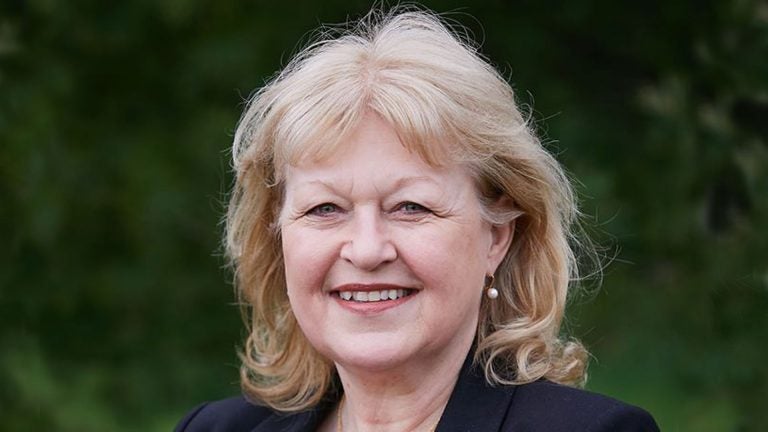Political gender gap still looms large in New Jersey
State Legislature’s female representation will drop to 30% at the start of 2020.

Republican Jean Stanfield won an open seat in the 8th District based in Burlington County. (Jean Stanfield/Facebook/NJ Spotlight)
This article originally appeared on NJ Spotlight.
—
New Jersey Democrats and Republicans can argue over which party had a better Election Day this year, but one group was a clear loser, at least at the state level: women.
Already lagging behind 19 other states, including nearby New York and Connecticut, in the percentage of lawmakers who are female, New Jersey stands to lose a net of one woman in the state Assembly come January, provided current results hold. That will drop the proportion of female representation in the state Legislature down to 30%. At the same time, more than 51% of those living in New Jersey are women, according to the latest data from the U.S. Census Bureau.
“This was basically a status quo election,” said Debbie Walsh, director of the Center for American Women and Politics (CAWP) at Rutgers University.
The gender gap in politics is not new and is not confined to New Jersey. According to CAWP, the 2,133 women state lawmakers across the country represent slightly less than 29% of all legislators. The ranks of women among state legislatures began to swell in the 1970s with the women’s rights movement and were relatively stagnant over the last two decades before increasing 14% this year.
A number of studies have attributed the political gender gap in part to women underestimating their qualifications to serve in office, being less likely to run unless encouraged to do so and being less likely to be recruited by political parties.
A record 60 women were on the Assembly ballot this year, an improvement of more than 10% over the previous record in 2013, according to CAWP. All 25 incumbents on the ballot won re-election. However, 34 of 35 challengers lost, with the exception being Jean Stanfield, a Republican who won an open seat in the 8th District based in Burlington County.
That one win is more than offset by the retirements of two sitting Assembly women — Democrat Patricia Egan Jones in the 5th District, which covers parts of Camden and Gloucester counties, and Republican Amy Handlin in the 13th in Monmouth. Both those women are being replaced by men.
Lack of opportunity
“Part of the challenge in New Jersey is that there just hasn’t been a lot of opportunity,” Walsh said. “There have not been a lot of open seats with women of that party (currently holding the seat) on the ballot.”
Contributing to that issue is an overall lack of turnover in the Legislature, Walsh noted. In a typical year, fewer than 10% of lawmakers choose to retire or resign. Unlike some other states, New Jersey does not have other state-level elective opportunities — such as treasurer, attorney general or comptroller — besides governor.
While at least having a record number of women on the ballot represents some progress, it often doesn’t mean much if the women are running as underdogs in districts that overwhelmingly favor one party or the other. That’s what the vast majority of the challengers did. Just eight female challengers ran for five open seats without an incumbent — in Districts 5, 8, 10, 13 and 25 — and only one of those, Stanfield, was a member of the party currently in power.
Assembly Speaker Craig Coughlin (D-Middlesex) said that the Democrats chose “terrific candidates,” many of whom were women, in an effort to win as many seats as possible this year.
“I think we had very aggressive campaigns with great resources,” said Coughlin, who on Thursday was re-elected to lead the Assembly. “There was a commitment on our part to make sure women had a chance to succeed, a real opportunity to win, but ultimately it’s in the hands of the voters.”
He noted that some of the women were in targeted, but tough, races, in the 8th, 21st District based in Union County and 25th in Morris, where Republicans held — and continue to hold — the seats. These were races that Democrats thought they had a chance at flipping based on changing demographics and past voting patterns.
Recruiting women candidates
Walsh said the parties need to do a better job of recruiting women candidates for seats without incumbents running in districts where they can win. Incumbents typically win re-election 95% of the time: This year, if current results hold, incumbents will have won 96.2% of races.
“We would recommend that when there are open seats, that the party seeks out women candidates,” she said. “That’s not the way it works in New Jersey now, on either side of the aisle.”
There are more female Democratic lawmakers in New Jersey and nationwide. In New Jersey, more than three-quarters of women in the Assembly are Democrats and of the Senate’s 10 women, only one is a Republican.
Only one Senate seat was on the ballot, in the southernmost 1st District, and that was held by a Democratic male and will be held by a Republican male in January.
Prior to this week’s election, there were 27 Assembly women, a little more than a third of the lower house, and 10 female senators, a quarter of that body. The total 37 women in the Legislature represent 30.8% of the total membership. Nineteen states have a better record, led by Nevada — the only state where more than a majority of lawmakers, 52.4%, are women. Mississippi has the smallest female legislative representation — 13.8%.
While the proportion of New Jersey legislators who are women remains significantly lower than the population, the Senate and Assembly are much more inclusive than at the start of the millennium, when Walsh said New Jersey ranked 43rd in the nation. Today, it ranks 20th.
High-ranking female legislators
There are a couple of women in high-ranking legislative positions. Loretta Weinberg (D-Bergen County) is the majority leader in the Senate, and M. Teresa Ruiz of Essex County is the Senate President Pro Tempore, meaning she presides when Sen. President Steve Sweeney (D-Gloucester) is not present. On the Assembly side, Eliana Pintor Marin of Essex County chairs the powerful budget committee, and Annette Quijano of Union is majority conference chair.
New Jersey also has a female lieutenant governor in Sheila Oliver, who was the second of only two women to serve as speaker of the Assembly in state history. While cabinet positions are appointments and not elected positions, New Jersey has a majority female cabinet chosen by Gov. Phil Murphy.
Both of New Jersey’s lieutenant governors have been women, with Kim Guadagno serving as the first to former Gov. Chris Christie from 2010 through January 2018. Two women have run for governor in the last two elections: the Republican Guadagno in 2017, and Democrat Barbara Buono, then a state senator, challenged Christie in 2013.
New Jersey has had one of the few female governors elected across the country, Republican Christie Whitman, who served from 1994 to 2001.
New Jersey’s current and future legislative makeups remain below record levels: There were 28 women in the Assembly in 2009 and 37 female members of the Legislature in 2014.
Women are faring slightly better in county offices, but not in local ones, according to Walsh. She said that currently a third of county freeholders are women, but only 27% of municipal governing bodies and just 15% of mayors.
“There’s a lot of room for improvement,” Walsh said.
WHYY is your source for fact-based, in-depth journalism and information. As a nonprofit organization, we rely on financial support from readers like you. Please give today.



